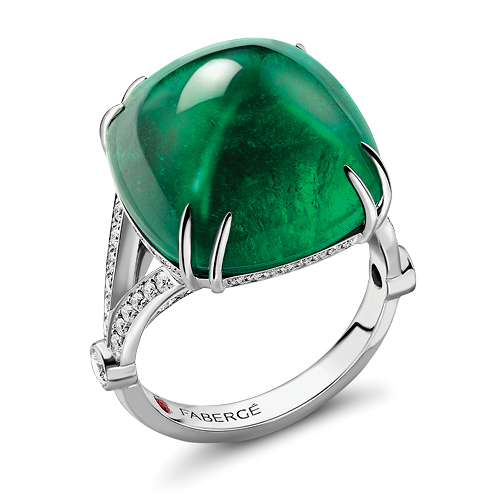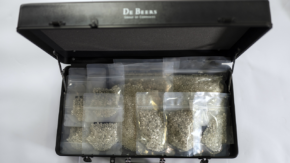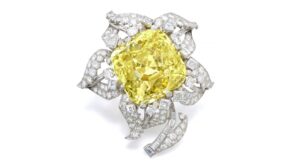Rubies, sapphires and emeralds form the most valuable trifecta in the colored-gem universe. But unlike the first two, which measure 9 on the Mohs hardness scale, emeralds rank at 7.5 to 8 and therefore require more care in handling. Due to various formation and extraction factors, it is natural for an emerald to contain fissures and fractures, which is why eye-visible inclusions are more acceptable in an emerald.
Global wealth expansion and the increased awareness and appreciation for emeralds have increased demand for top-notch stones in the face of limited supply. At the same time, connoisseurs of top-grade emeralds are developing less tolerance for inclusions, seeking an unnatural perfection from a natural gem. The result is that miners, lapidaries and merchants have increasingly been using clarity enhancement to meet the burgeoning demand.
Here, five gemstone experts talk about the practice of treating emeralds: gemologist and emerald specialist Coralie Nacht; gemologist Ken Scarratt; Michael S. Krzemnicki, director of the Swiss Gemmological Institute (SSEF); Jeffery Bergman, founder and director of Eighth Dimension Gems in Bangkok, Thailand; and Rodrigo Giraldo, founder and director of the Laboratory of Gemology RG.
What does it mean to clarity-enhance or treat an emerald, and what are the most popular methods the industry uses?
Nacht: The treatment of emeralds signifies the filling of fractures and cracks that reach the surface of the stone, [using] a substance that has a close refractive index to create a visual continuity and make them less visible to the naked eye.
This results in the enhancement of the emerald’s clarity. There are a variety of filling substances…such as mineral oils (Johnson & Johnson baby oil or paraffin), natural plant substances (cedarwood oil or the oleoresin Canada balsam), and finally epoxy-type resins, [of which] the most popular brand name is Opticon. The two most popular treatments are cedarwood oil and epoxy-type resins.
Some geographical origins favor a particular filling substance; for example, I [have seen] epoxy resin more often in emeralds from Colombia and Brazil than in emeralds from Zambia.
What is the difference between clarity enhancement and stabilization?
Scarratt: Clarity enhancement refers to modification of an emerald’s appearance by filling its fissures and fractures with a colorless to near-colorless material, which may be oil or wax or resin. However, in examining a finished emerald, one must determine whether the gem is clarity-enhanced or being held together by the resin.
Would the emerald fall apart if the resin were removed? If the answer is yes, it’s a case of stabilization and not simply clarity enhancement.
What’s the biggest challenge of dealing with an emerald that has already received a lab report?
Krzemnicki: Chain of custody. We have observed situations where an emerald obtained a “no oil” on the report [but was later] treated or clarity-enhanced. This is why, in the comment section of the SSEF report, we always write “At the time of testing.” When someone is deciding to buy an important emerald, we recommend that they get the stone checked again by a lab to be sure of the status of treatment, because that can impact the rarity and the price of the emerald.
It’s important to also understand that unlike heat treatment for rubies, the filler inside an emerald fissure may over time be impacted by a number of factors, such as how the emerald is set, climate exposure, temperature shock, degree of usage, aging of the filler substance, exposure to acid or soap, how fine or large the fissure is, and its location.

What’s the biggest misconception about oiling emeralds?
Bergman: When someone hears “cedarwood oil,” they are probably imagining something like olive oil or coconut oil. However, producing concentrated oil from cedarwood is a highly industrialized process.
Within the cedarwood-oil category, there is low viscosity, [which is] commonly used for wood treatments; medium viscosity, used for aromatherapy and perfumes; and high viscosity, [or] scientific-grade, used in research as an immersion oil for high-resolution microscopy work and for emerald clarity enhancements.
What types of enhancements do Colombian emeralds undergo?
Giraldo: Right now, most of the Colombian emeralds are sold in China. What they really want [there] is only minor or insignificant or no clarity enhancements. There are only three types of treatments in Colombia: resin (liquid), hardener with resin, and oil. Ninety percent of emeralds are enhanced with liquid resin, maybe 10% with hardener resin, and 3% to 4% are oiled.
The difference between liquid resin and hardener resin is [that] a hardener is introduced [to the latter type, which is then] used for extremely fractured rough emeralds that would be impossible to cut without [it]. The advantage with liquid resin is that it is a more stable filler compared to oil, and when necessary, it can be removed.
The main thing is always to disclose the product used and the amount of enhancement.
Why do gem labs occasionally report a combination of oil and resin in an emerald’s fissures?
Bergman: Before I answer that, one thing people are not talking about is that there is a lab-manufactured, high-viscosity, synthetic cedarwood oil which is half the price of the natural cedarwood oil, but nobody distinguishes between the “naturally occurring but industrially extracted” cedarwood oil and the synthetic one.
My experience is that most of the emerald dealers around the world, when they have “cedarwood oil only” treated gems, must re-treat them frequently. We are talking about flying [the gems] from Bogota to Los Angeles. The air pressure and temperature changes impact the filler, causing it to leak out, and the emeralds must be re-treated. In comparison, liquid resin is far more stable, but the problem is that it can be quite difficult to remove the resin and re-treat the emerald with oil only, which is one of the reasons we get reports stating that the filler is a mix of both oil and resin.
A further complication in the last decade is that Colombians have started mixing 10% high-viscosity cedarwood oil with 90% liquid resin, a product they have nicknamed “Ten Noventa” — noventa being the
Spanish word for 90.
When it comes to Zambian emeralds, liquid resin is predominantly being used, and for certain low-grade emeralds, a product called Joban, which is a green-colored oil, is applied in Jaipur.
What is the industry missing when it comes to educating customers about emeralds?
Scarratt:: When we buy a pair of trousers or a cashmere shawl, the garments come with care labels or washing instructions. But [with] emeralds — which may be worth a few thousand or a few hundred thousand dollars, if not more — clients are not given proper information on how they should care for their emeralds.
For example, if the emerald has been oiled, then the dealer should inform the customer that it is likely that the oil will leach out, particularly if they are traveling to a hot climate. Don’t go into the sauna with an emerald. So long as you inform people, the customer won’t have any problems.
Main image: Colombian emerald’s treatments seen at the Swiss Gemmological Institute. (SSEF)
This article is from the November-December 2023 issue of Rapaport Magazine. View other articles here.
Stay up to date by signing up for our diamond and jewelry industry news and analysis.



